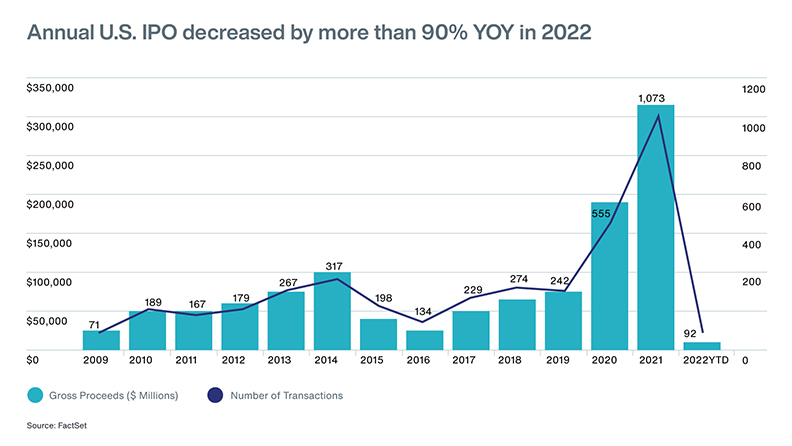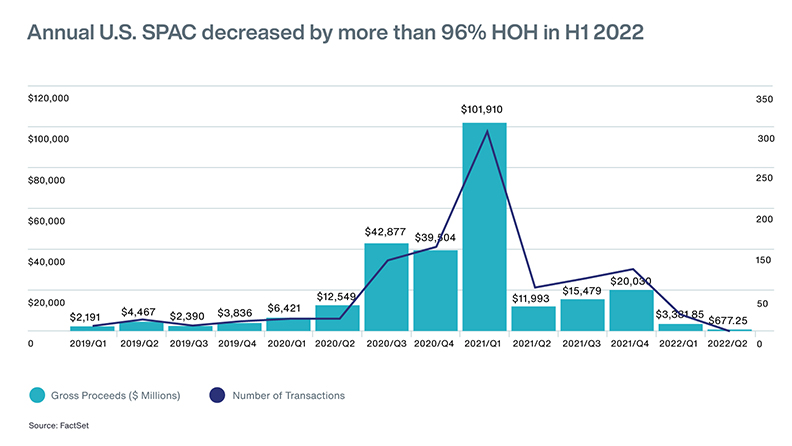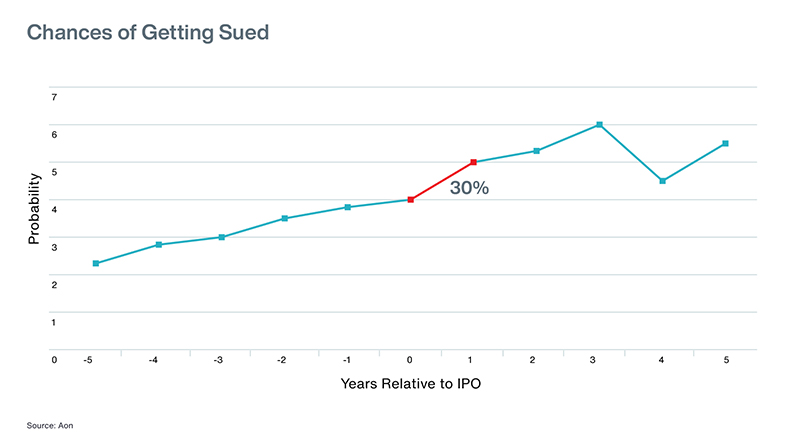Preparing for a US IPO: 5 Actions to Take Now
Contact Us
Going into 2023 and a possible capital market recovery, how can private companies best prepare the ground for a successful US IPO?
Key Takeaways
- While speed to transaction was a common theme in 2020 and 2021 and allowed companies to leverage favorable capital markets, private companies now have a better preparatory period to be ready for public transition.
- Companies should use this wait time to do preparatory work such as looking at their cyber policy, putting in place best practices around governance, and revisiting their Directors and Officers (D&O) Liability Insurance coverage.
- It is important for private companies to understand the obligations of a US publicly traded company and work with the right people with the right expertise to manage risks when the company’s profile changes from private to public.
2021 saw many digital economies announcing public listings (both US IPO and de-SPACS) due to optimism and increased demand for technology products/services due to the COVID-19 pandemic. “It was a real rush to take advantage of the positive capital market condition. So, many companies scrambled to get everything ready,” says Ho Wei Lin, Aon’s head of Digital Economies for Asia. “It was all about speed of transactions then, sometimes at the cost of less thorough preparation. However, that is not the case in 2022.”

Market uncertainty this year has caused the
longest US technology Initial Public Offering (IPO) drought in more than two decades. Increased capital market volatility due to geopolitical tensions in Europe, a dramatic drop in price of technology stocks, and complicated Chinese internet and foreign listing regulations have all played a part in sending US IPOs into limbo.

“A number of tech companies were planning to go public in 2022 but have since pulled back as the market condition may not yield the right reception and fundraising from capital markets,” says Ho. “Many companies have adopted a wait-and-see approach, holding off on IPOs this year but looking at doing them next year as investor confidence increases.”
"Companies should use this wait time to do preparatory work such as looking at their cyber policy, putting in place best practices around governance, and revisiting their Directors and Officers (D&O) Liability Insurance coverage.”
Ho Wei Lin, Head, Digital Economies – Asia, Aon
The cost of a poor plan
An IPO comes with myriad financial and operational concerns, ranging from governance, disclosure, and financial reporting requirements to talent retention as well as profitability.
In the case of SPAC transactions, businesses may be exposed to financial and reputational losses due to potential breaches of sellers’/management’s warranties & indemnities (whether innocent or malicious). This includes inaccurate financial statements of the target, adverse tax/regulatory proceedings, loss of material customers/relationships, cyber breaches, inadequate governance, or insufficient disaster recovery plans.
“While companies are putting off going public, it is opportune to start planning for it, putting in the right processes so that companies are ready to take swift action when market conditions improve,” says Ho.
“Companies should use this wait time to do preparatory work such as looking at their cyber policy, putting in place best practices around governance, and revisiting their Directors and Officers (D&O) Liability Insurance coverage,” she explains. “This will allow risk managers to take advantage of the current “downtime” and avoid any rush when going public in the near future.”
5 Actions to Take Now to Prepare for A US IPO
1. Build a robust cyber resilience strategy
2. Engage in human capital due diligence
3. Proactively address ESG matters
4. Manage heightened Intellectual Property risk
5. Relook at existing Directors and Officers (D&O) Liability Insurance coverage
1. Build a robust cyber resilience strategy
Cyber risk is now a key driver of losses, a
top business risk. This is further complicated by
governments implementing stricter regulatory regimes making it hard for digital economies to ignore the need for a robust cyber resilience strategy for prevention, detection, and response.
“Cyber attacks can considerably impact the financial resilience of any company,” says Adam Peckman Aon’s head of cyber solutions for APAC. “But those building up to a liquidity event, such as an IPO, are more vulnerable owing to the greater scrutiny they are under in the near term, by shareholders and regulators.”
The impact cyber attacks have on revenue, licenses to operate, or brand equity, can materially influence future valuations and consequently, the success of an IPO. Recent liquidity events in the technology and hotel industries saw negative adjustments to enterprise value in the order of hundreds of millions of dollars and further regulatory expense following the disclosure of cyber breaches.
Pre-IPO cyber resilience strategy should consider:
Assess: Have we assessed cyber threats to the business and determined how security controls directly impact balance sheet exposure?
Mitigate: Have we employed targeted security controls against industry standards to enhance security maturity, reduce exposure, and minimize financial impact from key cyber risks?
Transfer: Have we incorporated reasonable risk transfer solutions for cyber risk to safeguard the balance sheet and consequently, protect shareholder equity?
Recover: Have we implemented the range of business continuity, incident response, and claims protocols to expedite and future operational and financial loss recovery from a cyber attack?
2. Engage in human capital due diligence
One of the biggest risks facing pre-IPO companies is people risk. A crucial component of executing a successful IPO is no doubt having an agile and a resilient workforce that can adapt to the shifting needs of the business.
“Investors are looking to see if the organization’s employee value proposition is clearly defined, told in an authentic and compelling way, and experienced by employees,” says Alex Krasavin, Aon’s Enterprise Client Leader for APAC. “Investing in employees and instilling in them a sense of belonging will set companies up for success. Ultimately, a resilient workforce is essential for a resilient business.”
There are several areas to be mindful of:
- The Great Convergence – What is your strategy in managing external ongoing forces such as the impact of skills convergence, industry convergence, social and work-life convergence, and macroeconomic and stakeholder convergence?
- Leadership and behaviors – What capabilities are desirable for the organization as it goes public?
- Development and personal growth – Are opportunities provided to employees to ensure career growth? Do employees have a defined job architecture? Are career paths aligned to capability and skills needed within the organization?
- Rewards and well-being – Are your compensation philosophy and rewards programs well-defined to drive necessary behaviors in employees? Are you leveraging equity programs to drive a sense of ownership amongst employees?
- Hire for culture – Is your organization culture and experience driving brand advocacy within employees and the market?
- Measure the right metrics – Are you measuring return on value alongside return on investment?
3. Proactively address ESG matters
With fast-growing digital economies impacting the environmental, social and governance (ESG) priorities, companies must anticipate heightened regulatory conditions.
IPOs require companies to identify and address ESG issues pre-transaction to maximize value. This not only helps businesses to prevent overvaluing/paying for target companies, but also supports stock price post-deal, proactively addressing investor concerns to minimize shareholder action.
“While it is crucial to create a plan to address and disclose ESG strategies, risks, and opportunities, companies must focus on designing their own ESG story to attract investors,” says Pamela B. Greene, Aon’s head of North America Corporate Governance and ESG Consulting. “Failure to do so can lead to unsolicited scrutiny and an opportunity for others to craft your narrative.”
While governance has always been regulated through the stock exchange a company lists on, it is also critical to disclose material environmental and social risks. Companies can proactively address ESG issues by:
- Evaluating material ESG risks relevant to their specific industry and organization.
- Assessing how these risks are currently addressed internally, among peers and against best practice guidelines.
- Developing substantive policies to reduce material risks while capitalizing on business opportunities they may create.
- Ensuring that boards are well-rounded, with constituents who have public company experience.
- Establishing oversight procedures, charters and committees at the executive and board levels specifically for ESG.
4. Manage heightened Intellectual Property risk
Intangible assets, which make up 90 percent of the value of the S&P 500 now, have become the foundation of our global economy. This has significantly changed the business risk landscape and companies now face the growing challenge of recognizing, preserving, and protecting the value created by their intangible assets, including their intellectual property (IP).
“We advise companies to not only procure coverage to protect their core products and services against third party infringement, but also to insure the contractual indemnities that they are providing to their customers,” says Chris Rafferty, Aon’s Global Specialty Product Leader for IP solutions.
This is even more critical when companies look to go public as the risk of patent litigation increases in years leading up to and immediately following IPOs. The highest jump is observed in the year following the IPO, where the chances of being sued surge by 30%.

“Current insurance lines are insufficient given the significant IP exclusions within those policies,” Rafferty explains. For example, patent infringement is almost always excluded from insurance policies, as are other forms of IP infringement. “IP infringement allegations that occur during the normal course of business are also usually excluded from these types of policies,” he adds.
Risk managers can protect against IP vulnerability when preparing for an IPO by:
- Understanding their company’s current IP risk profile
- Getting a quantified outlook of their organization’s potential IP risk exposure
- Conducting risk management testing on insurable IP exposures (limits and coverage)
5. Relook at existing D&O risk cover
As private companies look to become public, so too should the type of risk management strategies they adopt. Director’s & Officers cover is an excellent case in point. Public company D&O insurance is more complex than its private company counterpart, reflecting the very real increase in potential personal liability exposure of the executive leadership of new public companies in litigation scenarios.
“The implementation of effective D&O insurance can minimize such risk and maximize value via strategies throughout the IPO maturity lifecycle,” says Mark Payne, Aon’s UK Commercial Risk Broker for D&O.
“We typically advise companies for us to help them set up a private D&O or take over their existing private D&O to iron out unfriendly clauses and ensure appropriate limit,” he adds. “We also encourage companies to start building relationships with insurers that will support a US public listing.”
For example, a tech-enabled logistic company’s existing private D&O limit was found to be 25x less than that of their competitors. Another digital economy company had restricted coverage and onerous exclusions in their D&O insurance program. These gaps in their D&O cover meant the companies’ risk profiles at the time of public listing could be adversely affected, with insurers perceiving them as having inadequate governance and risk management maturity.
“Private companies must understand the obligations of a US publicly-traded company,” says Payne. “They need to work with the right people with the right expertise to manage risks when the company’s profile changes from private to public.”
Plan, plan, plan
In the transition from private to public, or even as private companies prepare to be bought over, they are under scrutiny by shareholders and the market. “Companies have walked away from deals due to cyber risk, and others,” Greene explains.
In the ramp up to going public, companies must review their risk management practice, and evaluate their insurance portfolio, asking themselves questions such as what their overall insurance portfolio (Cyber, IP, D&O, etc.) looks like and whether they are buying adequate balance sheet protection.
“While speed to transaction was a common theme in 2020 and 2021 and allowed companies to leverage favorable capital markets, private companies now have a better preparatory period to be ready for public transition,” says Kristin Kraeger, Aon’s US National SPAC & IPO Leader. “It bodes well for companies to proactively start building relationships with risk management experts sooner rather than later in the process to more effectively capitalize on upcoming opportunities.”
"While speed to transaction was a common theme in 2020 and 2021 and allowed companies to leverage favorable capital markets, private companies now have a better preparatory period to be ready for public transition.”
Kristin Kraeger, US National SPAC & IPO Leader, Aon